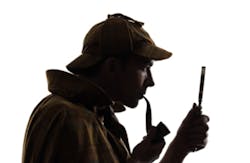Last month I described a sewage system where there sewage was measured by flowmeters at each of the four outfalls from the upper district, along with a total plant flowmeter at the inlet of the sewage treatment plant in the lower district. (Click here to read Part I.) Flow from the upper district (my client) was calculated by summing the flow measurements from the four outfalls. Flow from the lower district was calculated by subtracting the upper district flow from the total plant flowmeter. Flowmeter accuracy was questioned because the flow from the upper district was relatively high (per capita) as compared to the lower district. I was asked to investigate the flowmeters.
The upper district requested and obtained permission to examine the flowmeters and observe their calibration. A number of flowmeter issues were identified to include insufficient upstream straight run, inappropriate calibration techniques, incorrect transmitter location, an incorrectly located calibration scale, and inappropriate flowmeter operation. These issues had expensive economic consequences. For example, the error associated with the incorrectly located calibration scale represented approximately 15-20 percent of the average daily flow and nearly half of the penalty charges. Other issues had lesser (but insidious) effects on the charges and rates.
| Related Content: – “Part I: The Expert Witness”– “How does an increase in temperature affect liquids?” By David W. Spitzer |
I reported on these (and other) issues and eventually was asked to testify in court. In previous litigation, an expert (not specialized in flow measurement) opined that the flowmeters were acceptable and did not question their accuracy.
Therefore, for legal reasons, my testimony was limited to evidence of changes that had occurred since the previous litigation. The court found that nothing had changed — the flowmeters were not accurate at the time of the previous litigation, and they were still not accurate. Because nothing had changed, the court ruled in favor of the lower district and did not order the flowmeters to be fixed — despite repeated requests from the upper district.
David W. Spitzer is a regular contributor to Flow Control magazine and a principal in Spitzer and Boyes LLC, offering engineering, seminars, strategic, marketing consulting, distribution consulting and expert witness services for manufacturing and automation companies. He has more than 35 years of experience and has written over 10 books and 250 articles about flow measurement, instrumentation and process control.
Mr. Spitzer can be reached at 845 623-1830 or www.spitzerandboyes.com. Click on the "Products" tab in the navigation menu to find his "Consumer Guides" to various flow and level measurement technologies.



